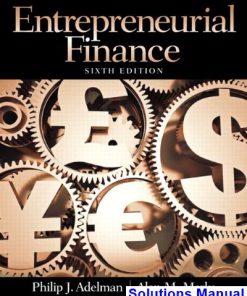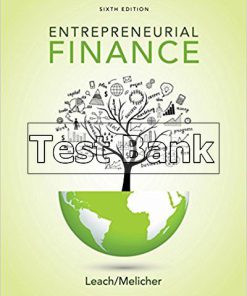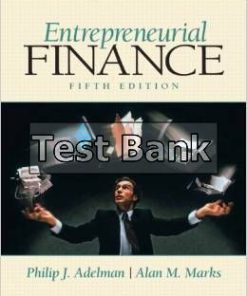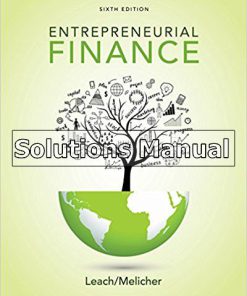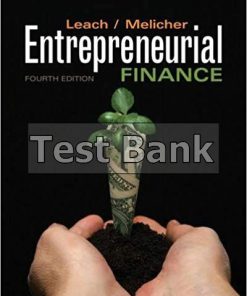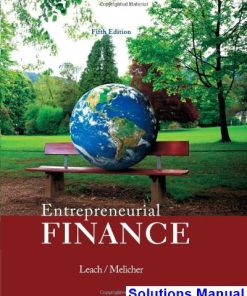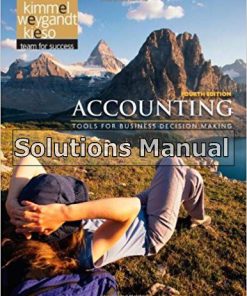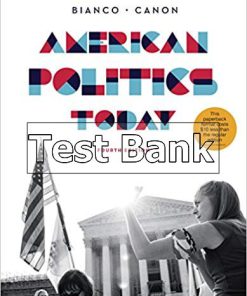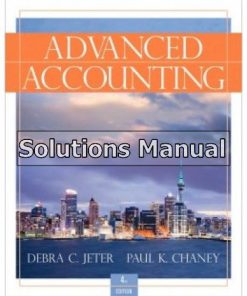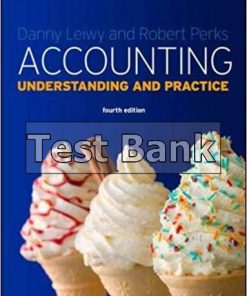Entrepreneurial Finance 4th Edition Leach Solutions Manual
$50.00 Original price was: $50.00.$26.50Current price is: $26.50.
Entrepreneurial Finance 4th Edition Leach Solutions Manual.
Entrepreneurial Finance 4th Edition Leach Solutions Manual
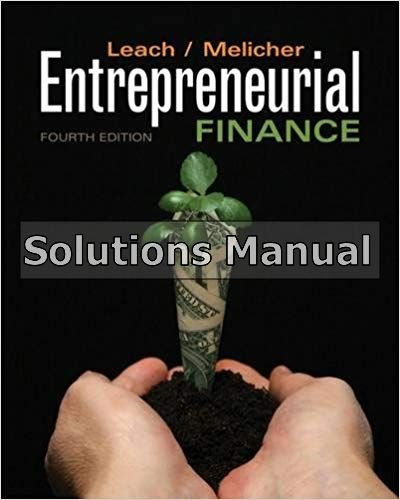
Product details:
- ISBN-10 : 0538478152
- ISBN-13 : 978-0538478151
- Author: J. Chris Leach
Learn to master today’s most effective corporate finance tools and techniques for successful entrepreneurial ventures with Leach/Melicher’s ENTREPRENEURIAL FINANCE, 4E. This reader-friendly edition closely follows a “life cycle of the firm” as it introduces the theories, knowledge, and financial tools any entrepreneur needs to start, build, and eventually harvest a successful business venture. Readers focus on sound financial management practices, such as how and where to obtain financial capital, the stages of financing, business cash flow models, and strategic positioning. Readers even gain important insights into effectively interacting with the financial institutions and regulatory agencies that are central to financing ventures. Trust ENTREPRENEURIAL FINANCE, 4E to provide the knowledge and insights needed for entrepreneurial success.
Table contents:
Chapter 1: Introduction to Entrepreneurial Finance
1.1 What is entrepreneurial finance?
1.2 Why is entrepreneurial finance challenging?
1.3 Why is entrepreneurial finance important?
1.4 Key facts about entrepreneurial finance
1.5 The entrepreneurial financing process
1.5.1 The need for frameworks
1.5.2 The FIRE framework
1.5.3 FIRE in practice
1.6 Who are the investors?
1.6.1 Main types of investors
1.6.2 The FUEL framework
Summary
Review questions
Chapter 2: Evaluating Venture Opportunities
2.1 Assessing Opportunities
2.1.1 The Venture Evaluation Matrix
2.1.2 The WorkHorse case study
2.2 Explaining the Venture Evaluation Matrix
2.2.1 Need
2.2.2 Solution
2.2.3 Team
2.2.4 Market
2.2.5 Competition
2.2.6 Network
2.2.7 Sales
2.2.8 Production
2.2.9 Organization
2.3 Drawing conclusions from the Venture Evaluation Matrix
2.3.1 Three perspectives on attractiveness
2.3.2 Three competitive advantages
2.3.3 Assessing risk
2.3.4 Interactions across cells
2.4 How entrepreneurs use the Venture Evaluation Matrix
2.4.1 The entrepreneur’s decision
2.4.2 Writing a business plan
2.5 How investors use the Venture Evaluation Matrix
2.5.1 The Venture Evaluation Matrix spreadsheet tool
2.5.2 Investor due diligence
2.5.3 The investor’s decision
Summary
Review questions
Chapter 3: The Financial Plan
3.1 The purpose of the financial plan
3.2 Financial projections
3.2.1 The three reflections
3.2.2 The structure of financial projections
3.2.3 Sources of information
3.2.4 Developing financial projections
3.3 Defining a timeline with milestones
3.4 Estimating revenues
3.4.1 The top-down approach
3.4.2 The bottom-up approach
3.4.3 Combining approaches
3.5 Estimating costs
3.5.1 Terminology
3.5.2 Costs of goods sold
3.5.3 Operating expenses
3.5.4 Capital expenditures
3.6 Pro forma financial statements
3.6.1 The structure of financial statements
3.6.2 Interpreting financial projections
3.6.3 Income versus cash flows
3.6.4 Testing financial projections
3.6.5 Simplifications
3.7 Formulating the financial plan
3.7.1 The attractiveness of the venture
3.7.2 Financing needs
3.7.3 Pitching the financial plan
Summary
Review questions
Chapter 4: Ownership and Returns
4.1 The mechanics of ownership and valuation
4.1.1 Pre-money and post-money valuation
4.1.2 Price and number of shares
4.1.3 Stock options
4.1.4 The capitalization table
4.1.5 Dilution with multiple rounds
4.2 Investor returns
4.2.1 Risk and return
4.2.2 Three measures of return
4.2.3 Comparing return measures
4.2.4 Returns with multiple rounds
4.3 The determinants of valuation and returns
4.3.1 The relationship between valuation and returns
4.3.2 The economic determinants of valuation
4.4 The determinants of founder ownership
4.4.1 Founder agreements
4.4.2 Principles for internal allocation
4.4.3 The FAST Tool
Summary
Review questions
Chapter 5: Valuation Methods
5.1 The valuation of entrepreneurial companies
5.1.1 The purpose of performing a valuation
5.1.2 The challenges of performing a valuation
5.2 The Venture Capital method
5.2.1 Valuation with a single investment round
5.2.2 Valuation with multiple investment rounds
5.2.3 Estimating the inputs
5.2.4 Model variants
5.3 The Discounted Cash Flow method
5.3.1 The mechanics of the DCF method
5.3.2 Estimating the inputs
5.4 Methods of Comparables
5.4.1 The Investment Comparables method
5.4.2 The Exit Comparables method
5.5 Modelling uncertainty
5.5.1 Scenario analysis and simulations
5.5.2 PROFEX
5.6 The choice of valuation model
Summary
Review questions
Chapter 6: Term Sheets
6.1 Term sheet fundamentals
6.1.1 The role of term sheets
6.1.2 Contingent contracting and milestones
6.1.3 Overview of terms
6.2 Cash flow rights
6.2.1 Convertible preferred stock
6.2.2 Participating preferred stock
6.2.3 Reasons for using preferred stock
6.3 Compensation
6.3.1 Founder employment agreements
6.3.2 Employee stock option plans
6.4 An overview of other terms
6.4.1 Control rights
6.4.2 Future fundraising
6.4.3 Investor liquidity
6.4.4 Additional clauses
6.5 Valuation versus terms
6.6 Convertible notes
6.6.1 How convertible notes work
6.6.2 Valuation caps
Summary
Review questions
Chapter 7: Structuring Deals
7.1 The art of structuring deals
7.2 The fundraising process
7.2.1 Preparing the fundraising campaign
7.2.2 Executing the fundraising campaign
7.2.3 Valuing an idea
7.3 Finding a match
7.3.1 Investor deal sourcing
7.3.2 Investor screening
7.3.3 The MATCH tool
7.4 Syndication
7.4.1 Reasons to syndicate
7.4.2 The structure of syndicates
7.5 Deal Negotiations
7.5.1 Bargaining theory
7.5.2 Negotiation analysis
7.5.3 Closing the deal
7.5.4 Deal negotiations with investor competition
7.6 Living with the deal
7.6.1 The importance of trust
7.6.2 A long-term perspective
Summary
Review questions
Chapter 8: Corporate Governance
8.1 The need for corporate governance
8.1.1 Why companies need investor involvement
8.1.2 Why investors oversee their companies
8.2 Corporate governance structures
8.2.1 Voting rights
8.2.2 Board of Directors
8.2.3 Informal control
8.3 Investor value-adding
8.3.1 Picking versus making winners
8.3.2 How investors add value
8.3.3 Where investors add value
8.3.4 The question of replacing managers
8.3.5 Assessing value-adding fit
Summary
Review questions
Chapter 9: Staged Financing
9.1 The rationale for staged financing
9.2 Structuring staged financing deals
9.2.1 Staged investments and ownership
9.2.2 The option value of staging
9.2.3 Tranching
9.2.4 Old versus new investors
9.3 Term sheets for staging
9.3.1 The liquidation stack
9.3.2 Anti-dilution rights
9.3.3 Additional rights
9.4 Managing financial difficulties
9.4.1 Down rounds
9.4.2 Turnarounds
9.5 Dynamic strategies
9.5.1 Dynamic investment strategies
9.5.2 Dynamic valuation profiles
Summary
Review questions
Chapter 10: Debt Financing
10.1 Fundamentals of debt
10.1.1 What is debt?
10.1.2 The structure of debt contracts
10.2 Debt versus equity
10.2.1 The fallacy that debt is cheaper than equity
10.2.2 Comparing debt and equity
10.3 Why banks don’t lend to startups
10.4 Alternative types of debt
10.4.1 Personal loans and credit cards
10.4.2 Trade credit
10.4.3 Discounting and factoring
10.4.4 Venture leasing
10.4.5 Venture debt
10.5 Valuation with debt
10.5.1 Enterprise versus equity value
10.5.2 Adjusting valuation methods for debt
Summary
Review questions
Chapter 11: Exit
11.1 The importance of exiting investments
11.1.1 Reasons for exit
11.1.2 The four main types of exit
11.1.3 The exit decision
11.1.4 The timing of exit
11.2 Initial Public Offerings
11.2.1 Benefits and costs
11.2.2 Preparing for an IPO
11.2.3 Pricing the IPO
11.2.4 Structuring the IPO
11.2.5 After the IPO
11.3 Acquisitions
11.3.1 Strategic motives
11.3.2 Preparing for an acquisition
11.3.3 Structuring an acquisition
11.3.4 After the acquisition
11.4 Sale to financial buyers
11.4.1 Buyouts
11.4.2 Secondary sales
11.5 Closing down the company
11.6 Determinants of the exit decision
11.6.1 Market forces
11.6.2 Economic fundamentals
11.6.3 Internal company dynamics
Summary
Review questions
Chapter 12: Venture Capital
12.1 The Venture Capital model
12.2 Institutional investors (LPs)
12.2.1 Portfolio allocation choices
12.2.2 Building a VC portfolio
12.3 Limited Partnership Agreements
12.3.1 Fund structure
12.3.2 Fund rules
12.3.3 GP compensation
12.3.4 GP incentives
12.4 VC firms (GPs)
12.4.1 Internal structure
12.4.2 Fundraising
12.4.3 Networks
12.4.4 Alternatives to the partnership model
12.5 Investment strategies
12.5.1 The investment strategy
12.5.2 Investment strategy styles
12.5.3 Implementing the investment strategy
12.5.4 An example
12.6 Risk and return in VC
12.6.1 Gross returns to the VC fund
12.6.2 Net returns to limited partners
12.6.3 Assessing VC fund performance
Summary
Chapter 13: Early Stage Investors
13.1 Founders, family, and friends
13.1.1 Reasons for investing
13.1.2 How family and friends invest
13.2 Angel investors
13.2.1 Different types of angel investors
13.2.2 How angels invest
13.3 Corporate investors
13.3.1 The motivation of corporate investors
13.3.2 The structure of corporate investors
13.3.3 How corporates invest
13.4 Crowdfunding
13.4.1 The structure of crowdfunding platforms
13.4.2 Motivations in crowdfunding
13.4.3 Crowdfunding campaigns
13.4.4 Returns from crowdfunding
13.5 Initial Coin Offerings
13.5.1 The Blockchain and cryptocurrencies
13.5.2 The structure of Initial Coin Offerings
13.5.3 The current debate about Initial Coin Offerings
13.6 Further investor types
13.6.1 Accelerators and incubators
13.6.2 Technology transfer funds
13.6.3 Social impact venture investors
13.7 Comparing early stage investors
Summary
Review questions
Chapter 14: Ecosystems
14.1 Entrepreneurial ecosystems
14.1.1 Ecosystem structure
14.1.2 Overview of leading ecosystems
14.2 How do entrepreneurial ecosystem work?
14.2.1 Interactions within the talent pool
14.2.2 Interactions with investors
14.2.3 Interactions with supporting parties
14.3 The role of government
14.3.1 Should the government support entrepreneurial ecosystems?
14.3.2 Government funding
14.3.3 Tax credits
14.3.4 Capital markets
14.3.5 Framework conditions
14.3.6 Demand side policies
14.4 Global ecosystems
14.4.1 The global movement of capital
14.4.2 The global movement of talent
Summary
Review questions
People also search:
entrepreneurial finance book
entrepreneurial finance 6th edition pdf free
entrepreneurial finance quizlet
entrepreneurial finance steven rogers pdf
venture capital and the finance of innovation 3rd edition pdf
Instant download after Payment is complete
You may also like…
Solutions Manual
Related products
Test Bank
Arts and Culture An Introduction to the Humanities Combined Volume 4th Edition Benton Test Bank
Solutions Manual





